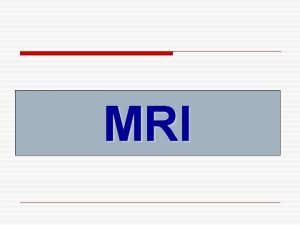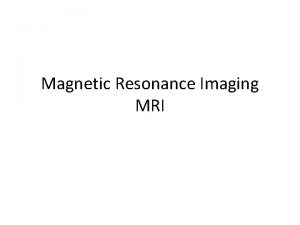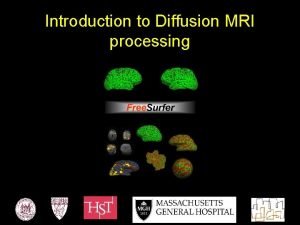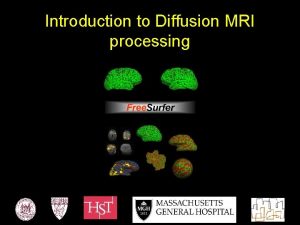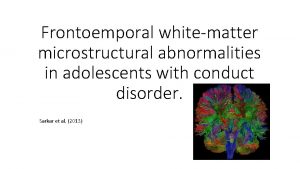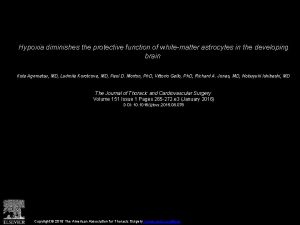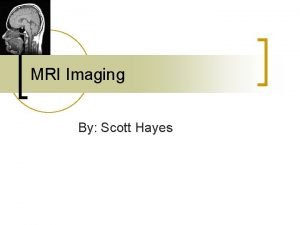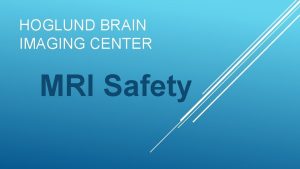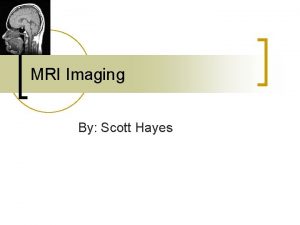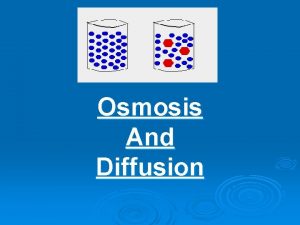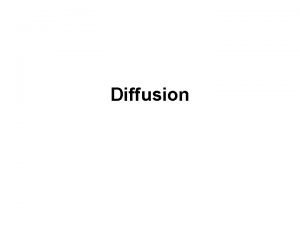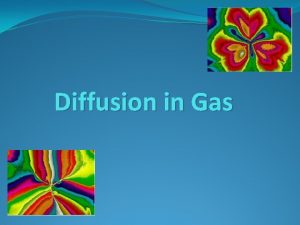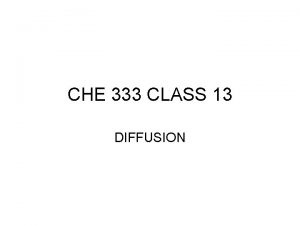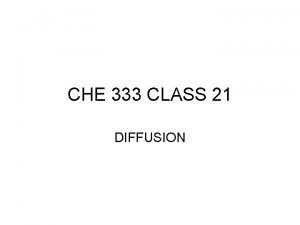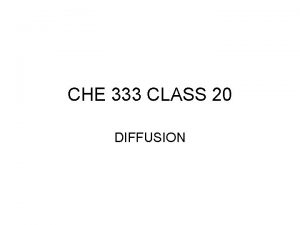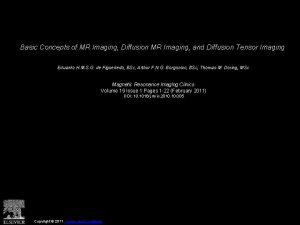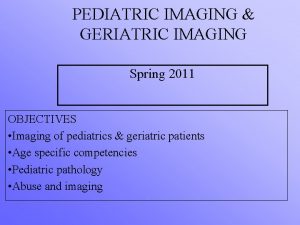Introduction to diffusion MRI Whitematter imaging From the


























- Slides: 26

Introduction to diffusion MRI

White-matter imaging • • From the National Institute on Aging Axons measure ~ m in width They group together in bundles that traverse the white matter We cannot image individual axons but we can image bundles with diffusion MRI Useful in studying neurodegenerative diseases, stroke, aging, development… From Gray's Anatomy: IX. Neurology Introduction to diffusion MRI 1/25

Diffusion in brain tissue • Differentiate between tissues based on the diffusion (random motion) of water molecules within them • Gray matter: Diffusion is unrestricted isotropic • White matter: Diffusion is restricted anisotropic Introduction to diffusion MRI 2/25

Diffusion MRI • Magnetic resonance imaging can provide “diffusion encoding” Diffusion encoding in direction g 1 g 2 g 3 • Magnetic field strength is varied by gradients in different directions • Image intensity is attenuated depending on water diffusion in each direction g 4 • Compare with baseline images to infer on diffusion process Introduction to diffusion MRI g 5 g 6 No diffusion encoding 3/25

How to represent diffusion • At every voxel we want to know: § Is this in white matter? § If yes, what pathway(s) is it part of? What is the orientation of diffusion? What is the magnitude of diffusion? • A grayscale image cannot capture all this! Introduction to diffusion MRI 4/25

Tensors • One way to express the notion of direction is a tensor D • A tensor is a 3 x 3 symmetric, positive-definite matrix: D= • d 11 d 12 d 13 d 12 d 23 d 13 d 23 d 33 D is symmetric 3 x 3 It has 6 unique elements • Suffices to estimate the upper (lower) triangular part Introduction to diffusion MRI 5/25

Eigenvalues & eigenvectors • The matrix D is positive-definite – It has 3 real, positive eigenvalues 1, 2, 3 > 0. – It has 3 orthogonal eigenvectors e 1, e 2, e 3. 2 e 2 1 e 1 3 e 3 D = 1 e 1´ + 2 e 2´ + 3 e 3´ ei = eigenvalue eigenvector Introduction to diffusion MRI eix eiy eiz 6/25

Physical interpretation • Eigenvectors express diffusion direction • Eigenvalues express diffusion magnitude Isotropic diffusion: 1 2 3 1 e 1 2 e 2 Anisotropic diffusion: 1 >> 2 3 2 e 2 1 e 1 3 e 3 • One such ellipsoid at each voxel: Likelihood of water molecule displacements at that voxel Introduction to diffusion MRI 7/25

Diffusion tensor imaging (DTI) Image: Tensor map: An intensity value at each voxel A tensor at each voxel Direction of eigenvector corresponding to greatest eigenvalue Introduction to diffusion MRI 8/25

Diffusion tensor imaging (DTI) Image: Tensor map: An intensity value at each voxel A tensor at each voxel Direction of eigenvector corresponding to greatest eigenvalue Red: L-R, Green: A-P, Blue: I-S Introduction to diffusion MRI 9/25

Summary measures Faster diffusion • Mean diffusivity (MD): Mean of the 3 eigenvalues Slower diffusion MD(j) = [ 1(j)+ 2(j)+ 3(j)]/3 Anisotropic diffusion Isotropic diffusion FA(j)2 = • Fractional anisotropy (FA): Variance of the 3 eigenvalues, normalized so that 0 (FA) 1 3 [ 1(j)-MD(j)]2 + [ 2(j)-MD(j)]2 + [ 3(j)-MD(j)]2 2 1(j)2 + 2(j)2 + 3(j)2 Introduction to diffusion MRI 10/25

More summary measures • Axial diffusivity: Greatest of the 3 eigenvalues AD(j) = 1(j) • Radial diffusivity: Average of 2 lesser eigenvalues RD(j) = [ 2(j) + 3(j)]/2 • Inter-voxel coherence: Average angle b/w the major eigenvector at some voxel and the major eigenvector at the voxels around it Introduction to diffusion MRI 11/25

Beyond the tensor • The tensor is an imperfect model: What if more than one major diffusion direction in the same voxel? • High angular resolution diffusion imaging (HARDI): More complex models to capture more complex microarchitecture – Mixture of tensors [Tuch’ 02] – Higher-rank tensor [Frank’ 02, Özarslan’ 03] – Ball-and-stick [Behrens’ 03] – Orientation distribution function [Tuch’ 04] – Diffusion spectrum [Wedeen’ 05] Introduction to diffusion MRI 12/25

Models of diffusion Diffusion spectrum (DSI): Full distribution of orientation and magnitude Orientation distribution function (Q-ball): No magnitude info, only orientation Ball-and-stick: Orientation and magnitude for up to N anisotropic compartments Tensor (DTI): Single orientation and magnitude Introduction to diffusion MRI 13/25

Example: DTI vs. DSI From Wedeen et al. , Mapping complex tissue architecture with diffusion spectrum magnetic resonance imaging, MRM 2005 Introduction to diffusion MRI 14/25

Data acquisition • Remember: A tensor has six unique parameters D= d 11 d 12 d 13 d 12 d 23 d 13 d 23 d 33 d 12 d 23 d 11 d 22 • To estimate six parameters at each voxel, must acquire at least six diffusion-weighted images • HARDI models have more parameters per voxel, so more images must be acquired Introduction to diffusion MRI 15/25

Choice 1: Gradient directions • True diffusion direction || Applied gradient direction Maximum attenuation Diffusion-encoding gradient g Displacement detected • True diffusion direction Applied gradient direction No attenuation Diffusion-encoding gradient g Displacement not detected • To capture all diffusion directions well, gradient directions should cover 3 D space uniformly Diffusion-encoding gradient g Displacement partly detected Introduction to diffusion MRI 16/25

How many directions? • Acquiring data with more gradient directions leads to: + More reliable estimation of diffusion measures – Increased imaging time Subject discomfort, more susceptible to artifacts due to motion, respiration, etc. • DTI: – Six directions is the minimum – Usually a few 10’s of directions – Diminishing returns after a certain number [Jones, 2004] • HARDI/DSI: – Usually a few 100’s of directions Introduction to diffusion MRI 17/25

Choice 2: The b-value • The b-value depends on acquisition parameters: b = 2 G 2 2 ( - /3) – the gyromagnetic ratio – G the strength of the diffusion-encoding gradient – the duration of each diffusion-encoding pulse – the interval b/w diffusion-encoding pulses 90� 180� acquisition G Introduction to diffusion MRI 18/25

How high b-value? • Increasing the b-value leads to: + Increased contrast b/w areas of higher and lower diffusivity in principle – Decreased signal-to-noise ratio Less reliable estimation of diffusion measures in practice • DTI: b ~ 1000 sec/mm 2 • HARDI/DSI: b ~ 10, 000 sec/mm 2 • Data can be acquired at multiple b-values for trade-off • Repeat acquisition and average to increase signal-to-noise ratio Introduction to diffusion MRI 19/25

Looking at the data A diffusion data set consists of: • A set of non-diffusion-weighted a. k. a “baseline” a. k. a. “low-b” images (b-value = 0) • A set of diffusion-weighted (DW) images acquired with different gradient directions g 1, g 2, … and b-value >0 • The diffusion-weighted images have lower intensity values b=0 b 1, g 1 b 2 , g 2 b 3 , g 3 Baseline image Diffusionweighted images b 4 , g 4 b 5 , g 5 Introduction to diffusion MRI b 6 , g 6 20/25

Distortions: Field inhomogeneities Signal loss • Causes: – Scanner-dependent (imperfections of main magnetic field) – Subject-dependent (changes in magnetic susceptibility in tissue/air interfaces) • Results: – Signal loss in interface areas – Geometric distortions (warping) of the entire image Introduction to diffusion MRI 21/25

Distortions: Eddy currents • Cause: Fast switching of diffusionencoding gradients induces eddy currents in conducting components • Eddy currents lead to residual gradients that shift the diffusion gradients • The shifts are direction-dependent, i. e. , different for each DW image • Result: Geometric distortions Introduction to diffusion MRI From Le Bihan et al. , Artifacts and pitfalls in diffusion MRI, JMRI 2006 22/25

Data analysis steps • Pre-process images to reduce distortions – Either register distorted DW images to an undistorted (non-DW) image – Or use information on distortions from separate scans (field map, residual gradients) • Fit a diffusion model at every voxel – DTI, DSI, Q-ball, … • Do tractography to reconstruct pathways and/or • Compute measures of anisotropy/diffusivity and compare them between populations – Voxel-based, ROI-based, or tract-based statistical analysis Introduction to diffusion MRI 23/25

Caution! • The FA map or color map is not enough to check if your gradient table is correct - display the tensor eigenvectors as lines • Corpus callosum on a coronal slice, cingulum on a sagittal slice Introduction to diffusion MRI 24/25

Tutorial • Use dt_recon to prepare DWI data for a simple voxel-based analysis: – Calculate and display FA/MD/… maps – Intra-subject registration (individual DWI to individual T 1) – Inter-subject registration (individual T 1 to common template) – Use anatomical segmentation (aparc+aseg) as a brain mask for DWIs – Map all FA/MD/… volumes to common template to perform voxel-based group comparison Introduction to diffusion MRI 25/25
 Frc control system
Frc control system Swabt
Swabt Relocation diffusion vs expansion diffusion
Relocation diffusion vs expansion diffusion Hát kết hợp bộ gõ cơ thể
Hát kết hợp bộ gõ cơ thể Frameset trong html5
Frameset trong html5 Bổ thể
Bổ thể Tỉ lệ cơ thể trẻ em
Tỉ lệ cơ thể trẻ em Voi kéo gỗ như thế nào
Voi kéo gỗ như thế nào Tư thế worm breton là gì
Tư thế worm breton là gì Chúa sống lại
Chúa sống lại Các môn thể thao bắt đầu bằng tiếng chạy
Các môn thể thao bắt đầu bằng tiếng chạy Thế nào là hệ số cao nhất
Thế nào là hệ số cao nhất Các châu lục và đại dương trên thế giới
Các châu lục và đại dương trên thế giới Công thức tính thế năng
Công thức tính thế năng Trời xanh đây là của chúng ta thể thơ
Trời xanh đây là của chúng ta thể thơ Cách giải mật thư tọa độ
Cách giải mật thư tọa độ 101012 bằng
101012 bằng Phản ứng thế ankan
Phản ứng thế ankan Các châu lục và đại dương trên thế giới
Các châu lục và đại dương trên thế giới Thơ thất ngôn tứ tuyệt đường luật
Thơ thất ngôn tứ tuyệt đường luật Quá trình desamine hóa có thể tạo ra
Quá trình desamine hóa có thể tạo ra Một số thể thơ truyền thống
Một số thể thơ truyền thống Cái miệng bé xinh thế chỉ nói điều hay thôi
Cái miệng bé xinh thế chỉ nói điều hay thôi Vẽ hình chiếu vuông góc của vật thể sau
Vẽ hình chiếu vuông góc của vật thể sau Thế nào là sự mỏi cơ
Thế nào là sự mỏi cơ đặc điểm cơ thể của người tối cổ
đặc điểm cơ thể của người tối cổ V cc
V cc



























